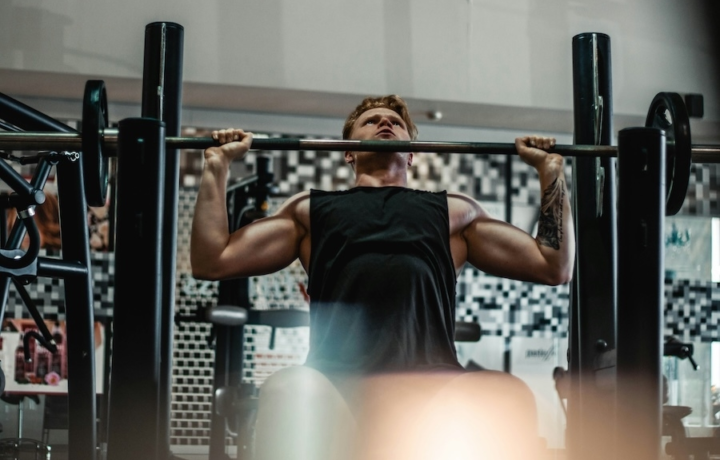Exercise
Rope Tricep Extension

Rope Tricep Extension
How to Perform
- Stand facing the cable machine with your feet shoulder-width apart and attach a rope to the upper pulley.
- Grasp the rope with both hands using an overhand grip, then step back to create tension on the cable while keeping your upper arms close to your head.
- Position your elbows at a 90-degree angle with your upper arms parallel to the floor and your palms facing each other.
- Brace your core and maintain a slight forward lean from your hips while keeping your spine neutral and shoulders down.
- Exhale as you extend your forearms downward by contracting your triceps, pushing the rope down and slightly outward until your arms are fully extended.
- Maintain fixed upper arm position throughout the movement, ensuring only your forearms move during the extension.
- Inhale as you slowly return to the starting position by bending at the elbows, allowing the weight to raise the rope back up in a controlled manner.
- Keep tension on the triceps throughout the entire movement, never fully relaxing at the top position or locking out the elbows at the bottom.
Important information
- Keep your elbows tucked in close to your head throughout the movement to maximize tricep engagement and minimize shoulder involvement.
- Maintain a neutral wrist position during the exercise to prevent unnecessary strain on the wrist joints.
- Adjust your distance from the cable machine so that the weight stack doesn't touch down between reps, maintaining constant tension on the triceps.
- Focus on the mind-muscle connection by consciously squeezing your triceps at the point of full extension for maximum benefit.

Rope Tricep Extension
Exercise Details
Primary Muscles
Muscle Groups
Mechanic
Risk Areas
Built for progress
Take the guesswork out of training
Create personalized AI-powered workout plans that evolve with you. Train smarter, track every rep and keep moving forward, one workout at a time.






The Rope Tricep Extension stands as one of the most effective isolation exercises for developing impressive triceps definition and strength. This intermediate-level movement has earned its place as a staple in bodybuilding routines for decades, targeting all three heads of the triceps brachii with particular emphasis on the medial and lateral heads. Unlike compound movements that distribute tension across multiple muscle groups, the Rope Tricep Extension creates focused stress directly on the triceps, making it ideal for those looking to add specific detail and size to the back of their arms. The use of a rope attachment provides a unique advantage by allowing natural wrist rotation throughout the movement, reducing unnatural stress on the joints while maximizing muscle fiber recruitment.
For bodybuilders specifically, this exercise offers remarkable versatility within a training program. It can be positioned early in a workout for heavier loading when triceps are fresh, or saved for the finale to achieve that coveted muscle pump and metabolic stress necessary for hypertrophy. The exercise responds well to various rep ranges: lower reps with heavier weight for strength development, or higher rep schemes for muscular endurance and that skin-splitting pump. What makes the Rope Tricep Extension particularly valuable in a strength-building context is its ability to strengthen the lockout portion of pressing movements. Athletes who struggle with the final phase of bench presses or overhead presses often find that dedicated tricep work through extensions directly translates to improved performance in these compound lifts.
While seemingly straightforward, mastering the mind-muscle connection with this movement transforms it from a simple accessory exercise into a powerful triceps developer. The adaptability of this exercise makes it suitable for training cycles focused on strength, hypertrophy, or even endurance, securing its position as a cornerstone movement for anyone serious about developing impressive, functional triceps.
FAQ - Rope Tricep Extension
The Rope Tricep Extension primarily targets all three heads of the triceps brachii, with particular emphasis on the medial and lateral heads. This isolation exercise minimizes involvement from other muscle groups, making it highly effective for specific triceps development.
Keep your upper arms stationary and close to your sides throughout the movement, extending only at the elbow joint. Maintain a slight forward lean from the hips, avoid rounding your back, and focus on fully extending your arms at the bottom of the movement without locking out your elbows.
For optimal triceps development, include this exercise 1-2 times weekly with at least 48 hours of recovery between sessions. Position it after compound pressing movements like bench press or shoulder press when programming your workout.
Avoid bending your elbows to compensate for limited shoulder mobility, as this negates the stretching benefits. Don't rush through repetitions or use momentum—move slowly and deliberately. Also, never force the movement beyond the point of mild discomfort, as this could lead to shoulder strain.
To make it easier, reduce the weight and focus on higher repetitions or use a single-arm variation. For increased difficulty, add more weight, slow down the eccentric (lowering) phase to 3-4 seconds, or try drop sets by performing consecutive sets with decreasing weight without rest.






